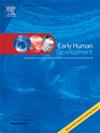孕期母体抑郁情绪和血清素能抗抑郁药治疗对胎儿-新生儿神经行为的连续性有不同影响。
IF 2.2
3区 医学
Q2 OBSTETRICS & GYNECOLOGY
引用次数: 0
摘要
背景:产前5-羟色胺再摄取抑制剂(SRI)抗抑郁剂暴露与新生儿神经行为紊乱有关,但目前仍不清楚这是否反映了一种短暂的药理状况,还是妊娠期SRI持续暴露导致的子宫内神经发育轨迹改变。目的:本研究探讨了第三孕期胎儿生理和新生儿神经行为之间的纵向关系,并确定产前SRI或抑郁暴露是否会影响早期神经行为的连续性:参与者为 127 名孕妇及其胎儿-新生儿后代。根据产前抑郁症状和 SRI 治疗情况分为四组:对照组(n = 51)、抑郁组(未用药;n = 35)、SRI-抑郁组(n = 26)和 SRI-非抑郁组(n = 15)。在妊娠 36 周时对胎儿心率(fHR)、运动活动和血管血流动力学进行多普勒测量,然后在出生后第 7 天对新生儿神经行为成熟度进行评估。利用偏最小二乘法分析确定了胎儿-新生儿测量指标之间的潜在相关性;通过分层回归测试组间调节作用进一步研究了相关性:结果:两个维度描述了胎儿生理指标与新生儿神经行为指标之间 74% 的协方差(经置换的 p 结论):母亲抑郁,无论是未接受药物治疗还是接受 SRI 治疗且情绪症状持续/控制不佳,都会对胎儿-新生儿神经行为的连续性产生不同程度的影响。这些研究结果表明,神经行为紊乱可能在出生前就已存在,并强调了在孕期进行有效心理健康管理的重要性。本文章由计算机程序翻译,如有差异,请以英文原文为准。
Maternal depressed mood and serotonergic antidepressant treatment during pregnancy differentially shape the continuity between fetal–newborn neurobehaviour
Background
Prenatal serotonin reuptake inhibitor (SRI) antidepressant exposure is associated with newborn neurobehavioural disturbances, but it remains unclear whether this reflects a transient pharmacologic condition or an altered neurodevelopmental trajectory emerging in utero from sustained gestational SRI exposure.
Aim
This study explored longitudinal relationships between third-trimester fetal physiology and newborn neurobehaviour, and determined whether early neurobehavioural continuity is shaped by prenatal SRI or depression exposure.
Methods
Participants were 127 pregnant mothers and their fetal-newborn offspring. Four groups were defined based on antenatal depressive symptoms and SRI treatment: Control (n = 51), Depressed (unmedicated; n = 35), SRI-Depressed (n = 26) and SRI-Non-Depressed (n = 15). Doppler measures of fetal heart rate (fHR), motor activity and vascular hemodynamics were obtained at 36-weeks' gestation, then newborn neurobehavioural maturity was evaluated at postnatal day-7. Partial least squares analysis was used to identify latent correlations between fetal-newborn measures; associations were further studied with hierarchical regression testing group moderation.
Results
Two dimensions described 74% of the covariance between fetal physiologic and newborn neurobehavioural measures (permuted p < 0.05). Three latent fetal-newborn relationships were significantly moderated by group: (1) lower fHR variability, and (2) greater fHR decelerations, predicted lower alertness/orientation scores but only in SRI-Depressed-group newborns; and (3) lower fetal cerebrovascular resistance predicted lower motor scores in Depressed-group newborns. SRI treatment to euthymia was not associated with fetal-newborn neurobehavioural disturbances.
Conclusions
Maternal depression, both unmedicated and SRI-treated with persistent/poorly-managed mood symptoms, differentially shaped fetal-newborn neurobehavioural continuity. These findings suggest that neurobehavioural disturbances may predate birth, and underscore the importance of effective mental health management during pregnancy.
求助全文
通过发布文献求助,成功后即可免费获取论文全文。
去求助
来源期刊

Early human development
医学-妇产科学
CiteScore
4.40
自引率
4.00%
发文量
100
审稿时长
46 days
期刊介绍:
Established as an authoritative, highly cited voice on early human development, Early Human Development provides a unique opportunity for researchers and clinicians to bridge the communication gap between disciplines. Creating a forum for the productive exchange of ideas concerning early human growth and development, the journal publishes original research and clinical papers with particular emphasis on the continuum between fetal life and the perinatal period; aspects of postnatal growth influenced by early events; and the safeguarding of the quality of human survival.
The first comprehensive and interdisciplinary journal in this area of growing importance, Early Human Development offers pertinent contributions to the following subject areas:
Fetology; perinatology; pediatrics; growth and development; obstetrics; reproduction and fertility; epidemiology; behavioural sciences; nutrition and metabolism; teratology; neurology; brain biology; developmental psychology and screening.
 求助内容:
求助内容: 应助结果提醒方式:
应助结果提醒方式:


